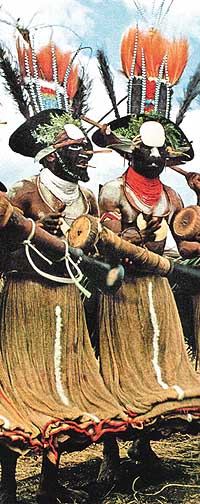by Chalerm Raksanti
Truly off the beaten path of commercial tourism, the
Mount Hagen highlands of Papua New Guinea are the home of scores of
tribesmen, living in their jungle houses. Once considered a part of
Australia, people in this area were virtually unknown to outsiders until
the 1930s. It was a group of Australian prospectors who ventured into the
rugged region in search of gold and discovered the lost world of the Wahgi
Valley, northeast of Port Moresby. Surprisingly, this remote area turned
out to be one of the most densely populated parts of all New Guinea at the
time. For many years thereafter, the tribes remained separated by clan
rivalry, diverse languages, and natural barriers imposed by the Central
and Bismarck mountain ranges.
 Enga
tribesmen in ceremonial dress.
Enga
tribesmen in ceremonial dress.
In the 1960s, encouraged by the Australians, tribes
banded together and formed a farm cooperative. Some tribes grew coffee,
others raised tea. Today, these Stone Age people have a surprisingly
vibrant economy and the once warring tribes have schools, hospitals and
are learning more modern techniques of agriculture. Slowly they are being
eased into the 21st century. But the old ways still run deep and the few
modern conveniences one finds in their villages are trifles.
Their everyday lives are still based on traditions,
rituals and festivals. Progress has not deprived them of their joy in
simple pleasures. And behind the fa็ade of improved education and
hygiene lurks the warrior of old. Bows and arrows and bellicose looks
belie the happy contentment of the tribesmen who trudge to the coffee and
tea plantations.
It is at their annual festivals that we see the true
exuberance of these proud tribes. Every highlander is a style-setter.
Vivid paint and hypnotic stares create a memorable visage. A ghoulish
‘mud-man’ from the Asaro River Valley will don a helmet of dried clay
and smear mud over his body to portray an evil spirit. In a macabre dance
with his fellow tribesmen he will step to the rhythm of leaves struck
against his thighs.
 A
guard mask and cassowary bird plumes make up this man’s finery.
A
guard mask and cassowary bird plumes make up this man’s finery.
A chorus line of warriors rise and dip, sending the
bark-string bilum skirts they wear curling like a breaking ocean’s wave.
An eerie “shhh” rushes through their clenched teeth with the sound of
a locomotive chuffing out of a station as the drum pounding Enga men from
Mount Hagen perform their ceremonial dance.
Polka-dot make-up, scarification done in tribal
designs, and pig grease enhance the appeal of a Minj clanswoman. Her
facial design copies the pattern of a tree python. Trading store items,
beads and arm bands, will often join her traditional finery.
 A
tribesman admiring the effect of hours of primping.
A
tribesman admiring the effect of hours of primping.
An Enga tribesman wears a harlequin-like guard mask,
and struts under a wig of cassowary plumes in imitation of the bird. A
teenage girl wears carmine and gold paint over her tattoos. Costumes and
cosmetics once differentiated tribes at local gatherings. But as the
tribes met and blended ideas for decoration jump from man to man. Self
adornment now is more up to the individual and is a form of personal
expression rather than a tribal distinction.